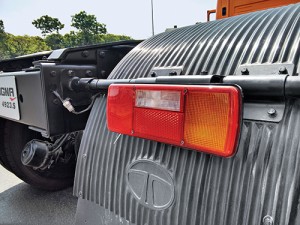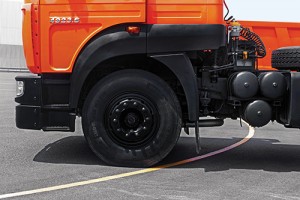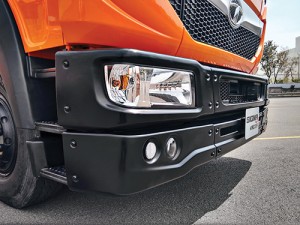The Signa marks an interesting and cost effective facelift of the highly popular LPT, LPS or LPK range of trucks from Tata Motors
Story by: Bhushan Mhapralkar
Photos: Ashish Bhatia
The LPT, LPS or LPK range of trucks from Tata Motors are extremely popular with operators; albeit in the form of a construction tipper or a haulage truck in the 25- to 49-tonne category. On any National Highway in India, chances are that every third heavy-duty truck is a LPT (also referred to as the Legacy range). The unique identification feature of this truck is its fully built cabin. Examples include the LPT 4018 or LPT 4923 tractor. The two tractors among themselves are known to command over 70 per cent of the market in Rajasthan, which is also India’s largest tractor trailer market. Even in the construction and mining tipper segment, the LPK range enjoys much popularity. At the forefront when it comes to word of mouth publicity, and not without a reason, the Legacy range is the main stay of Tata Motors’ Medium and Heavy Commercial Vehicle (M&HCV) segment. It is the bread and butter earner. Upgrading itself continuously without losing sight of the operator, the Legacy range has made the next big move, and is now called the Signa.
Signa calling
Work on the Signa, according to Ravi Pisharody, Executive Director – Commercial Vehicles, Tata Motors, began three to four years ago. Coming at a nominal cost increase, the Signa was born out of the need to upgrade the cabin so that the product would be ready for the next 10 years. Pisharody mentioned, “In the main segment of 25- to 49-tonne, and what we would call as our main platform earlier, we also felt the need to bring the earlier nomenclatures like 4923 or 4018 under a brand. Thus was born the Signa. The cabin on this truck is equal or better than most other cabins available. What better, the upgrade comes at a nominal cost increase. The value will be much more. The powertrain has not changed, and the Signa will have telematics 100 per cent.”
One look at the Signa, and the connection with the LPT cabin is apparent at once. Painted in an attractive shade of orange, the Signa definitely looks modern than the LPT would. If the rake of the pillars and the large windshield indicate the presence of an LPT cabin, the application of composite panels with a brushed-aluminium lookalike embellishment and wind channels at the respective corners firmly point at a significant visual and functional change. They are also light in weight. If the metal cabin presents the operator the advantage of lower repair costs without compromising safety, the chunky metal bumper below houses modern clear lens headlamp and turn indicator assemblies. “We resorted to a metal bumper because of the feedback we received from the operators. It is a three piece design to facilitate easy repairs and replacement in case of damage,” explained Dr. A K Jindal. The chunky bumper with headlamp assemblies in it looks inspired by that of the Prima. The design of the composite panels (including the mesh grille) was also done in a way such that they would flaunt the Tata business look.
Walk over, and the plastic wheel arch cladding draws attention. Also evident are the heightened levels of fit and finish. Panel gaps are tighter and even. Averred Dr. Jindal, “The challenge was to execute changes without changing the BIW. Tools and dies were changed to arrive at tighter panels gaps. The door toolings were changed to incorporate double sealing qualities.” Climb aboard the two point suspended (non-tiltable) cabin, and the composite dashboard draws attention. It is an indication of the rising use of plastics, and looks quite modern. Look around, and the surrounding trim is as modern. Even the moulded roof panel, composite door panels, and the seats with integrated headrests. The seats, said Dr. Jindal, reflect a new signature. They are also found on the Ultra. The driver’s seat is suspended. To cut down NVH (Noise, Vibration & Harshness), the cabin was effectively insulated (and sealed).
Frugal engineering
Retaining existing nomenclatures like 4923 or 4018, the Signa makes an interesting example of frugal engineering. Mentioned Pisharody, “The Signa looks on par with the current products. Many of our competitors are new while we have been in the market for 60 years. A need for upgrade was therefore felt. The Prima could not have taken the place of the Signa because of the bells and whistles it offers. Prima’s cabin is heavier, and it is possible that buyers may not prefer it in the interest of the cost of operation. The Signa will take care of the products like the 3118 that has had good cabin sales. With a phased rollout of the Signa planned, and in line with the segments where cabin sales range from high to low, the Signa retains the mechanicals of the LPT range. The engine is a Cummins ISBe 5.9-litre unit governed electronically or mechanically. Electronic governance will take precedence once BS VI emission norms are enforced pan-India in 2017. As of now, the 2518.K, for example, comes with a 180 PS mechanically governed BS III compliant engine. The 4923.S comes with an electronically governed 230 PS engine. Transmission is Tata’s own 9-speed G1150 design. The rear axle on the 6×4 4923.S tractor is a single reduction RA109SRT unit.
Behind the wheel
Behind the wheel, the first impression is that of space. Signa’s cabin is spacious. According to Dr. Jindal, it is the widest in the segment. The suspended seat helps to arrive at a commanding driving position. The modern surrounding has an ‘uplifting’ effect. As the engine wakes up, not much noise intrudes into the cabin. revealing at once that the effect of insulating the cabin is successful. With the air-conditioning on, and the windows rolled up, conversation is easily accomplished. The suspended seat also adds to the comfort levels. For someone who is going to spend active years of his life behind the wheel of such a truck travelling the length and breath of the country, or ferrying overburden out of mines, it is absolutely necessary that the cabin is a comfortable and pleasant place to be in. Fitting the bill, the Signa’s cabin also translates into safety. It is capable of supporting higher productivity and faster turnaround time. The focus of the work, explained Dr. Jindal, was on the driver being able to clock faster turnaround times and achieve higher productivity.
Behind the wheel, as I work through the lower range of ratios, and then tap the lever to move into the higher range, the difference is palpable. As the engine revs up to put out the animal-like torque, the difference in the tipper cabin, which is a day cabin, is obvious. The rise in refinement levels are apparent. It is clear, that without losing sight of the dandy nature of the LPT cabin, the team at Tata Motors has subtly brought about a big change. The modern looking instrument cluster is easy to read past the large rim diameter two-spoke steering wheel. Employing parabolic leaf springs and bogie suspension, the 4923.S tractor presents an idea of how the market is shifting to higher tonnage vehicles. Both, the 4923.S and the 3118.T rigid haulage truck are equipped with a sleeper cabin. The cabin of the 4923.S, considering its nature of use, contains two sleeper bunks to support continuous operation. It can thus clock faster turnaround time. Large glass area ensures good visibility all round.
Long live the legacy
Set to replace the Legacy range, the Signa marks a significant achievement. Without touching the driveline or the mechanicals of the LPT, LPS or LPK range of trucks, which have come to be the main stay of Tata Motors, and are the preferred choice of the operators, the Signa has incorporated modernity; is capable of delivering higher productivity and efficiency.






























